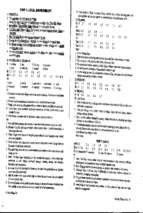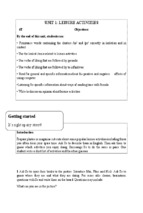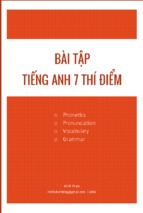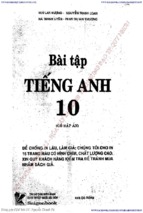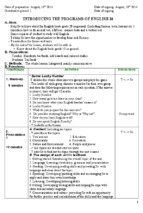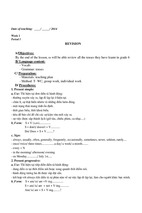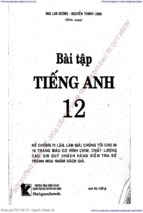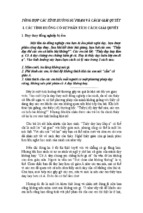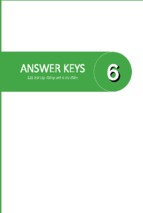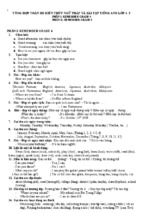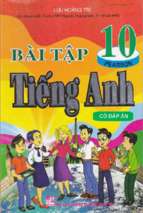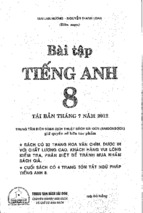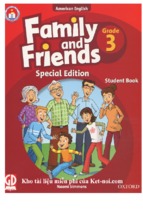GIÁO ÁN ENGLISH 12
Unit 3: WAYS OF SOCIALISING
A: READING
A. OBJECTIVES:
By the end of the lesson, students will:
-
Read for specific information about The ways of socialising.
-
Be able to talk some back ground information of The ways of socialising.
-
Give the Vietnamese equivalents to the following words and phrases.
-
Decide which of the three options below is the best title for the passage and answer the
questions of the lesson.
B. TEACHING AIDS:
- Textbook, pictures, cassette, tape, handouts and real objects.
C. PROCEDURE:
Method: mainly communicative
Teacher’s activities
Students’ activities
I. Warm-up: Jumbled words
- Write the words whose letters are in a random - Whole class.
order on the board.
- Divide the class into two teams. Ss from two
- Go to the board and write the correct words.
teams go to the board and write the correct words.
- The team which writes correct words first will
be the winner.
1. Osiacsilgin
2. Fo
3. Sawy
Answer : 1 socialising, 2 of, 3 ways
- Have Ss guess the phrase of words above ways - The team which writes correct words first will be
of socialising
the winner.
- Lead in: T asks Ss to open the textbook on page
GIÁO ÁN ENGLISH 12
31.
T: Today we are going to learn Unit 3 - Ways of
socialising- A: Reading
II. Before you read:
- Ask students to look at the pictures, work in
pairs to ask and answer the questions:
1. What are the people in the picture doing?
2. Can you guess what they say to each other?
3. What will you do / say if:
+ You want to get your teacher’s attention in
class?
- Pairs work
- Discuss
- Answers
+ You need to ask someone a question, but they
are busy talking to someone else?
2. They may be greeting each other.
- Go around to offer help.
3. If we want to get our teacher’s attention in
class, we can raise our hands slightly.
1. In the pictures, people are shaking hands and
waving with each other.
- Call on some Ss to present their answers and
If we need to ask someone a question, but they
elicits comments from other Ss. Give feedback if are busy talking to someone else, we can…
necessary.
* Teaching Vocabulary:
- Ask Ss to skim the passage and underline the
- Skim the passage and underline the new words.
new words.
- Explain the new words.
1. Attract (v)
2. Assistance (n)
3. Whistle (v)
4. Clap (v)
5. Attention: (n)
- Give the Vietnamese equivalent.
GIÁO ÁN ENGLISH 12
6. Acceptable (a)
- Listen and repeat after the teacher.
7. Compliment: (n): (synonym)
8. Decent: ( adj) (situation)
- Copy down.
9. Appropriate: (adj) (translation)
10. Kidding(n) (situation)
11. Signal (n): (example)
12. Marvellous: (adj): (synonym)
- Ask Ss to give the Vietnamese equivalent (if - Give the Vietnamese equivalent to the following
necessary).
words and phrases.
- Read a new word three times. Ss listen and
repeat after the teacher.
III. While you read:
- Read the passage quickly and stop at the words
to guess their meanings.
1. Task 1
- Write these words on the board:
Present answers:
- Verbal (a)
- verbal (a):
- Non - verbal (a)
- non - verbal (a);
- Attract someone’s attention
- attract someone’s attention:
- Impolite (a) # polite (a)
- impolite (a) # polite (a):
- Rude (a) # polite
- rude(a) # polite:
- Informality (adv) # formality
- informality (adv) # formality:
- Approach (v)
- approach (v):
- A slight nod will do
- a slight nod will do:
- Ask Ss to give the Vietnamese equivalent to the - Work in pairs
following words and phrases.
GIÁO ÁN ENGLISH 12
- Instruct Ss to read the passage quickly and stop
at the words to guess their meanings.
- Guess the meaning of the words based on the
context in the sentences.
- Check that Ss understand the word correctly.
- Call some students to give the answers.
- Ask others students to correct.
- Give the true answers..
2. Task 2
- Ask students to read the questions carefully.
- Read the passage more carefully and choose the
best title for it.
- Ask students to read through the passage again.
- Devide the class into pairs to do .
- Call some students to give the answers.
- Ask others students to correct.
- Give the true answers..
3. Task 3
Questions and answers:
Answers
A. (Attracting Attention: Non- verbal Cues)
- Work in pairs and ask and answer the questions
in the book basing on the information in the
reading passage.
Answers
1. We can use either verbal or non - verbal
- Ask Ss to work in pairs and ask and answer the communication.
questions in the book basing on the information in
2. Because they are strong actions that can easily
the reading passage.
be seen.
- Ask Ss to read the text again and write down the
3. We can wait until he passes near us, catch his
answers to the following questions.
eye, nod slightly to let him know we would like
- Move around class to give help.
him to come to our table. Or we may raise our
hand slightly to show that we need assistance.
- Call on some pairs to present their answers in
front of the class.
4. You can use a small friendly wave to attract his
or her attention.
GIÁO ÁN ENGLISH 12
- Give correct answers.
5. Because it’s considered rude.
IV. After you read:
* Discussion
- Ask Ss to work in pairs to discuss the meaning - Work in pairs to discuss the meaning of whisling
of whisling and hand - clapping in Vietnamese and hand clapping in Vietnamese culture.
culture.
- Learn by heart the lesson.
- Move around to help Ss.
- Review the points that have been covered in the
- Ask some pairs to act out their conversation.
lesson and do the exercise in the exercise book.
- Give feedback.
V. Homework:
- Ask Ss to learn by heart the lesson.
- Review the points that have been covered in the
lesson and do the exercise in the exercise book.
- Prepare the next part: Speaking.
- Prepare the next part: Speaking.
GIÁO ÁN ENGLISH 12
Unit 3: WAYS OF SOCIALISING
B: SPEAKING
A. OBJECTIVES:
-
By the end of the lesson, students will:
Practise speaking exactly and appropriately about the ways of socialising, based on the
vocabulary and structures that they have learnt in the lesson.
Make dialogues to practise giving and responding to compliments, based on the given
information.
B. TEACHING AIDS:
- Textbook, pictures, cassette, tape, handouts and real objects
C. PROCEDURE:
Method: mainly communicative.
Teacher’s activities
I. Warm-up:
Students’ activities
Listen to the teacher.
Guessing word:
T: What is it?
- Work in groups
- Divide the class into two groups.
- Say that he has a word in his mind and he going to
give some information about the word. Members of
each group will listen and may stop at any
information they hear to guess what the word is.
Each group has only two chances to gues the word.
The first group to tell exactly what the word is wins
the game.
- Give information about the word.
1. It’s a noun.
2. It has got ten letters.
3. It is an expression by word or action, or
admiration.
- Listen and find out the answers.
GIÁO ÁN ENGLISH 12
4. It shows one respect, give and respond your
feeling about things which are beautiful,
good, or interesting, etc.
What is the word?
- Give the correct answer.
Answer key: COMPLIMENT
II. Pre- speaking:
Task 1:
- Introduces the task: You are going to work in
your group to practise reading these dialogues,
paying attention to how people give and respond - Work in pairs.
to compliments in each situation.
Elicit the new words by asking Ss.
Vocabulary:
- Compliment (n)
- Hairstyle (n)
- Terrific (a)
- Kidding (a)
- Ask Ss to take notes and practise reading
vocabulary.
- Look at the table on the board.
- Ask Ss to work in pairs, practise reading these
dialogues, paying attention to how people give and
respond to compliments in each situation.
- Read once. Ask Ss to listen.
- Listen to the teacher.
- Hang the table on the board. Ask Ss to look at the
information about compliments in the table.
Useful language:
Give compliments
-
beautiful
Respond to
compliments
-
Thank you /
- Take notes.
GIÁO ÁN ENGLISH 12
- perfect
- I’ve never seen…
- terrific
- better
I think
Thanks
- That’s a nice
compliment
I think
- Use the information in the table to suitable
information and play the roles in the dialogues
to practise the dialogues.
I’m glad you like it.
- What a / an……you have
Thank you. I think /
/ have got!
thought……………
- How + adj /
Thank you. That’s a
adv…………
nice compliment.
- You really
You must have got
have……………
to be kidding.
- Your ……is / are…
- Ask Ss to use the information in the table to
suitable information and play the roles in the
dialogues to practise the dialogues.
- Move around to give help.
III. While- speaking:
Task 2:
- Work in pairs.
- Listen and look at the information in the task.
- Some pairs perform. Others listen to.
- Read the cues once. Ask Ss to listen and look at the
David: You really have a beautiful dress. It is
information in the task.
the most beautiful dress I have seen.
- Explain the situations of each dialogues.
Hung: Your motorbike is really terrific. Then…
- Guide Ss to use suitable compliments in each
Michel: I Though your
dialogues, using the cues.
- Ask Ss to work in pairs, practise giving
compliments to suit the responses.
badminton was a lot better ….
- Work in groups.
GIÁO ÁN ENGLISH 12
- Move around to give help.
- Listen to the teacher.
- Call on some pairs to act out their conversation in - Listen to the teacher.
front of the class.
- Act out their conversation in front of the class.
- Give comments on their conversations.
- Thank you, Phil. I think you can do it as well
Task 3
as I do.
- Read the cues once. Ask Ss to listen and look at the - Thank you, Peter. That’s a nice compliment.
information in the task.
- You must be kidding. I think it is acceptable.
- Explain the situations of each dialogues.
- Work in pairs.
- Guide Ss to use suitable compliments in each
dialogues, using the cues.
- Share with the other pairs.
- Ask Ss to work in pairs, practise responding
compliments to suit the responses.
- Move around to give help.
- Present the dialogues.
- Take note teacher’s feedback.
+ A nice pair of glasses:
- Call on some pairs to act out their conversation in
front of the class.
A: Your pair of glasses are really nice. I
really like them.
- Give comments on their conversations.
B: Really, Peter. I just bought it yesterday.
IV. Post speaking:
Task 4:
- Before getting Ss to discuss, T reminds them of
some useful expressions for giving and responding
compliments in Task 1.
+ A new and expensive watch;
A: You really have a new and expensive
watch, ……… How did you get it?
B: Thank you, ……… My father bought it
for me on my birthday.
- Divide the class into small groups of 3 or 4 and get
+ A new cell phone:
them to discuss the task.
- Go around to check and offer help.
A: Your new cell phone looks great. I have
never seen such a nice one before.
- After checking that all the groups have finished, T
B: Thanks. I finally found a suitable one for
calls on the representative of each group to report
me
their peer’ ideas. T check if other groups would have
- Make compliments and responses about
GIÁO ÁN ENGLISH 12
the same or different ideas.
- Listen and take note of their errors. T provides
corrective feedback after that.
V. Home work:
- Work with your friends: Make compliments and
responses about something or performances of your
friends in class.
- Study
- Speaking English
- Singing
- Briefcase/ a new pen/ a nice hat/
- Prepare the next part.
something or performances of your friends in
class.
-
Study, Speaking English, Singing,
Briefcase / a new pen / a nice hat /
- Prepare the next part.
GIÁO ÁN ENGLISH 12
Unit 3: WAYS OF SOCIALISING
C: LISTENING
A. OBJECTIVES:
-
By the end of the lesson, students will:
Develop extensive listening skills.
Use the information they have listened to for other communicative tasks..
B. TEACHING AIDS:
- Textbook, pictures, cassette, tape, handouts and real objects
C. PROCEDURE:
Method: mainly communicative
Teacher’s activities
Students’ activities
I. Warm up:
Jumbled words:
- Write the words whose letters are in a random
order on the board.
- Pairs work
- Rearrange
- Divide the class into two teams. Ss from two
teams go to the board and write the correct
words. - The team which writes correct words
first will be the winner.
Aniotuergl Regulation
Oenetlehp Telephone
Lacl Call
Acidev Advice.
II .Before you listen:
T sets the scene: You are going to listen to
Linda Cupple, a social worker, advises young
people on how to use the telephone in her - Whole class
GIÁO ÁN ENGLISH 12
family. Listen to her talk and decide whether - Listen to the teacher.
the statements are true(T) or false (F).
- Ask Ss to look at the pictures in the textbook
and answer the questions.
- Elicit the new words by asking questions,
using the techniques suggested above.
- Look at the pictures in the textbook and answer the
questions.
Vocabulary:
- Argument (n)
- Regulation (n)
- Absolute (a)
- Maximum (n,a)
- Install (v)
- Chitchat (n)
- Starling (a)
Listen and repeat:
- Answer the teacher's questions.
+ They are greeting….
+ They are saying goodbye…
- Help Ss to pronounce the words in their book
correctly.
- Play the tape and then ask Ss to repeat after
the tape in chorus and individually.
- Correct errors, if any.
- Check that Ss know the meaning of these - Take notes
words.
III. While you listen:
Task 1:
- Get Ss to read through the statements to
- Listen to the tape and read in chorus and
understand them and underline the key words.
individually
- Guide students the requests of the task.
- Let students listen twice times.
GIÁO ÁN ENGLISH 12
- Write on board from 1 to 6 and call some
students to come and write their answers.
- Individual work, pair work and whole class.
- Let them listen on again and correct.
- Correct.
- Read through all the questions, identify the
information they need to look for in each question
(question word: what, where, when, how…)
- Listen and answer the questions.
- Answers
Task 2: Gap- fill
T: Now listen to the rest of the listening text
again and work in pairs to write the missing
words. You will listen to the tape twice.
- Check if Ss can answer the questions in task
2 without listening again. Play the tape for
them to listen again but before doing this, T
should encourage Ss to read through all the
questions, identify the information they need to
look for in each question.
1. T
2. F
3. T
4. F
5. F
6. T
- Individual work, pair work and whole class.
- Read through all the questions, identify the
- Play the tape again for Ss to listen and answer information they need to look for in each question.
the questions
- Get Ss to check their answers with a partner.
- Check with the whole class.
- Play the tape twice.
- Call on some pairs to give the answers.
- Go over the answers with the class.
IV. After you listen:
- Check their answers with a partner
GIÁO ÁN ENGLISH 12
- Before getting Ss to summarize Ms Linda
Cupple’s talk, T reminds them of some useful
languages Task 1, 2.
Suggested ideas:
- Give the answers.
- Length of time for each call
- Time for calling
- Calling late at night
- Calling at weekend
- Divide the class into small groups of 3 or 4
and get them to summarise the listening
passage.
- Go around to check and offer help.
- Answer:
1. agreed
5. waking
2. to avoid
6. heart
3. particular
7. kindness
4. adults
8. to stick
- After checking that all the groups have
finished. - Call on the representative of each - Individual work, pair work and whole class.
group to report their peer’ ideas. T check if
other groups would have the same or different
ideas.
- Listen and take note of their errors. T
provides corrective feedback after that.
V. Homework:
- Ask Ss to learn the new words by heart.
- Summarize Ms Linda Cupple’s talk
- Learn the new words by heart.
- Review the points that have been covered in the
lesson and do the exercise in the exercise book.
- Review the points that have been covered in
the lesson and do the exercise in the exercise - Prepare the next part.
book.
- Prepare the next part.
GIÁO ÁN ENGLISH 12
Unit 3: WAYS OF SOCIALISING
D: WRITING
A. OBJECTIVES:
By the end of the lesson, students will:
- Can use the words to build complete sentences in Task 1.
- Put the jumbled sentences in their correct order and then rearrange them to write
the complete paragraphs in Task 2.
B. TEACHING AIDS:
- Textbook, pictures, cassette, tape, handouts and real objects.
C. PROCEDURE:
Method: mainly communicative.
Teacher’s activities
Students’ activities
I. Warm –up: MATCHING
- Give the table on the board and ask Ss to
- Ss think what T asks, give their key.
match them in correct orders.
a. Pointing at
someone
b. Being late for
class
1. saying goodbye
2. admitting
wrongdoing
one’s
c. Making mistakes
3. saying“I’m sorry
I’m late ”
d. Being into the
farewell
4. being rule and
impolite
- Check mistakes
Pre-teach :
Vocabulary
- Abruptly
- (to) Apologize
- Discourtesy
- Ss correct .
Key: a + 4; b + 3; c + 2 ; d + 1
- Look at the board, listen to the teacher and take
notes.
GIÁO ÁN ENGLISH 12
- Gosh
- Sorrow
- Give the Vietnamese equivalent (if necessary).
- Read a new word three times, listen and repeat after
the teacher.
- Pleasant and thoughtful
- Ask Ss to give the Vietnamese equivalent (if
- Ss listen, repeat and copy them.
necessary).
- Ss rewrite some words.
- Read a new word three times. Ss listen and
repeat after the T.
- Ss know what they are going to learn.
II. Pre-writing:
- Ss work in pairs and discuss how to make sentences
Task1 : Use the words to make sentences. with required words.
Change the form of the verb. (No addition or
- Ss compare their key and show them.
omission is required)
- Ss correct .
- Introduce the aims of tasks in writing lesson.
Key:
In task 1, T asks Ss to discuss how to use
suggested words in sentences.
1. There are many ways to tell someone goodbye,
and most of them depend on the situation at hand.
- Go around the class to help Ss if necessary.
- Ask Ss to show their key. T gives key to
check.
2. However, there is one rule that all situations
observe: We seldom say goodbye abruptly.
3. In English it is necessary to prepare a person for
departure.
4. We lead into the farewell by saying something
pleasant and thoughtful like “I’ve really enjoyed
talking to you”.
III. While writing:
5. We might also say something relating to the time
- Ask Ss to work in pairs or in groups to read like“Gosh, I can’t believe how late it is ! I really
and discuss about the reordered paragraphs.
must be going!”
- Go around giving help.
- Work in pairs or in groups to read and discuss
- Ask Ss to compare their answers in pairs and about the reordered paragraphs.
read aloud in front of the class.
- Compare their answers in pairs and read aloud in
- Ask Ss to read their answers.
front of the class
GIÁO ÁN ENGLISH 12
- Listen to Ss and collect their mistakes for - Give comments on the others’ writing
indirect correction.
Paragraph 1:
Checking
- Correct with Ss.
1. C
2. E
3. A
4. B
5. D
- Give feedback on Ss’ work.
- Point out some common mistakes made by Ss.
- Ask Ss to give comments on the others’
writing.
2. If we have done something to hurt someone’s
feeling, we apologize.
Paragraph 2:
1. C
2. E
1. It is difficult to write rules that tell exactly when
you should apologize, but it is not difficult to learn
how.
3. B
4. A
5. D
3. An apology indicates that we realize we’ve made a
1. The simplest way to apologize is to say “ I’m mistake, and we’re sorry for it.
sorry”.
4. It’s a way of expressing our regret or sorrow for
2. Let’s take a common situation. Tom is late something.
for class and enters the classroom.
5. When we apologize, we admit our wrongdoing or
3. What does he do? The most polite actionis discourtesy, usually a reason for it, and express
usually to take a seat as quitely as possible and regret.
apologize later.
4. But if the teacher stops and waits for him to
say something, he could apologize simply “ I’m
sorry I’m late”, ask permission to take his seat
and sit down.
5. Naturally, more than this is needed, but it is
- Work in pairs to discuss the questions
not the time for it because it has already caused
some interruption and doesn’t need to make it
any longer.
- Give their answers.
IV. Post-writing:
Dicussion:
GIÁO ÁN ENGLISH 12
- Ask Ss to work in pairs to discuss the
question:
- In what ways people tell someone goodbye?
- Go around giving help.
- Ask some Ss to give their answers.
- Listen to Ss and collect their mistakes for
indirect correction.
V. Homework:
- Ask Ss to learn by heart the lessson
- Learn by heart the lessson
- Review the points that have been covered in
the lesson and do the exercise in the exercise - Review the points that have been covered in the
book.
lesson and do the exercise in the exercise book.
- Prepare for the next part.
- Prepare for the next part.
GIÁO ÁN ENGLISH 12
Unit 3 WAYS OF SOCIALISING
E: LANGUAGE FOCUS
A. AIMS:
By the end of the lesson, students will be able to:
- Distinguish the stress in two - syllable words.
- Know how to use: Reported speech and transform direct speech into reported speech
following correct rules.
B. AIDS : - Textbook, workbook, pictures, cassette, (colored) chalks, table
C. Methods :
- Communicative approach & learner- centered approach
Teacher’s activities
Students’ activities
1. Presentation
Pronunciation:
* Listen and repeat:
- Hang on a flipchart of the stress in two - sylable - Look at the board, listen to the teacher and take
words on the board and introduce the pronunciation to notes
the Ss. - Teacher plays the tape, ask Ss to listen.
attract
waving
signal
polite
discuss
walking
instance
police
suppose
pointing
student
between
* Repetition:
- Ask Ss to read the words aloud.
- Practice reading aloud the sentences.
- Read the words aloud
GIÁO ÁN ENGLISH 12
- Ask some Ss to read the aloud the sentences.
- Read aloud the sentences.
- Correct their mistakes if necessary.
GRAMMAR:
T hangs the table on the board, ask Ss to look at it
- Whole class
and listen to the teacher.
Reported speech: statement
Present the notes in reported statements:
- Look at the board, listen to the teacher and take
1. If the reporting verb is the past tense (e.g, said, told),
notes
it is usual for the verb in the reported clause to move
“ one tense back”
Present => past
Present perfect => past perfect
- Give some examples and rewrite the sentences
using the above structures.
Past => past perfect
“ I’m going” => He said he was going.
1/ He said : "I want to go to see An tomorrow"
=> he said that he wanted to go to see An the next
2. If the reporting verb is in the present tense ( e.g,
day
says, asks), there is no tense change.
The train will be late.=> He says the train will be late.
3. The one tense back rule also applies to reported
thoughts and feelings.
2/ An said to me : "I will buy a car"
=> An told me that he would buy a new car
3/ She said : "I have worked here for one year"
I thought she was married, but she isn’t.
=> She said (that) she had worked there for one year
Typical pronoun, time, place and modal verb changes
4/ His father said to him : "You must study harder"
=> Hisfather told him that he had to study harder
4.1 Pronoun changes
Direct speech
I
Reported speech
he/ she
5/ The doctor said to Nam : "You should stay in
bed"
=> The doctor told Nam that he should stay in bed
- Xem thêm -

